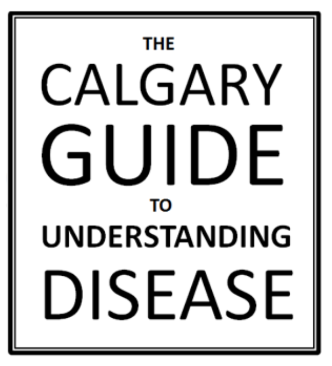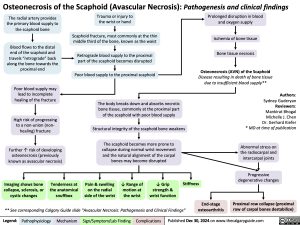Osteonecrosis of the Scaphoid (Avascular Necrosis): Pathogenesis and clinical findings
The radial artery provides the primary blood supply to the scaphoid bone
Blood flows to the distal
end of the scaphoid and travels “retrograde” back along the bone towards the proximal end
Poor blood supply may lead to incomplete healing of the fracture
High risk of progressing to a non-union (non- healing) fracture
Further ↑ risk of developing osteonecrosis (previously known as avascular necrosis)
Trauma or injury to the wrist or hand
Scaphoid fracture, most commonly at the thin middle third of the bone, known as the waist
Retrograde blood supply to the proximal part of the scaphoid becomes disrupted
Poor blood supply to the proximal scaphoid
The body breaks down and absorbs necrotic bone tissue, commonly at the proximal part of the scaphoid with poor blood supply
Structural integrity of the scaphoid bone weakens
The scaphoid becomes more prone to collapse during normal wrist movement and the natural alignment of the carpal bones may become disrupted
Prolonged disruption in blood and oxygen supply
Ischemia of bone tissue Bone tissue necrosis
Osteonecrosis (AVN) of the Scaphoid
Disease resulting in death of bone tissue due to insufficient blood supply**
Authors: Sydney Guderyan Reviewers: Mankirat Bhogal Michelle J. Chen Dr. Gerhard Kiefer * MD at time of publication
Abnormal stress on the radiocarpal and intercarpal joints
Progressive degenerative changes
Proximal row collapse (proximal row of carpal bones destabilize)
Imaging shows bone collapse, sclerosis, or cystic changes
Tenderness at the anatomical snuffbox
Pain & swelling on the radial side of the wrist
↓ Range of motion at the wrist
↓ Grip strength & wrist function
Stiffness
** See corresponding Calgary Guide slide “Avascular Necrosis: Pathogenesis and Clinical Findings”
End-stage osteoarthritis
Legend:
Pathophysiology
Mechanism
Sign/Symptom/Lab Finding
Complications
Published Dec 30, 2024 on www.thecalgaryguide.com

